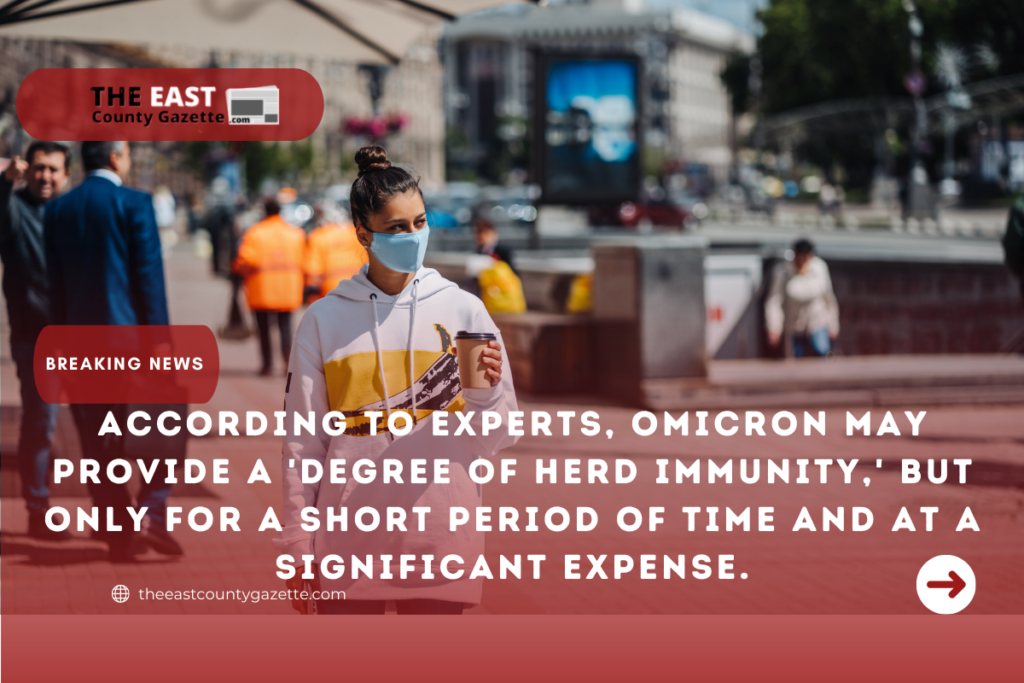Several experts are questioning whether the United States would be able to achieve herd immunity after reporting a record high of more than 1 million new COVID-19 cases on Monday, nearly two years after the outbreak began.
A lot of discussions have been going around about this being the big wave that will ultimately bring the virus to the majority of the population.

“It is feasible that we will achieve herd immunity as a result of this Omicron wave,” says Dr. Luis Ostrosky, chief of infectious diseases at McGovern Medical School at the University of Texas Health Science Center at Houston and professor of infectious diseases.
Read More: Fully Vaccinated Americans Are Getting Omicron in the US. Here’s Why?
Nachman Ash, Israel’s senior health adviser, agreed, recently stating that the country’s rising levels of Omicron infections have led him to assume that the country is on the verge of achieving herd immunity.
According to Ash, the director-general of the Health Ministry, “the [infection] numbers will have to be quite high in order to achieve herd immunity.” “This is something that is doable.”
Generally speaking, herd immunity occurs when a large proportion of the population is immune, and the virus or bacteria can’t find a host in which to replicate, as described by the medical profession in the following paragraph.
Herd immunity can be created in two ways: by having a large enough number of people get an infection and subsequently develop natural immunity, or by having a large number of people receive vaccinations. According to the Mayo Clinic, around 94 percent of the population must be immune in order to successfully prevent transmission of the virus.
Herd immunity, and in particular herd immunity against the COVID-19 virus, has its limitations, according to Ostrosky, who believes that it is likely to be time-sensitive. “We always detect a decrease in antibodies a few months after the procedure,” he says.
Not only is the immunity provided time-limited, but it may also be ineffective against other coronavirus mutations, depending on the circumstances. It is important to note that infection with this particular variety does not imply protection against future versions, according to Ostrosky.
As long as COVID-19 has the ability to mutate, long-term immunity is unlikely to be achieved. ‘If yet another mutation or variant of concern emerges that is more entirely resistant to the antibodies people have built up, we have to start from the beginning,’ Dr. Gregory Poland, director of the Mayo Clinic’s Vaccine Research Group, said on Tuesday.
“It’s a risky idea to say, ‘Let’s go for it,’ because it’s a risky venture.” Let’s work together to achieve herd immunity. Ostrosky believes that if everyone becomes afflicted, “we’ll be finished.”
There is also a very serious drawback to natural herd immunity, which is that a large number of people will become infected and, simply by virtue of the sheer number of people affected, could wind up in the hospital and die, according to Ostrosky.
It’s for this reason that we haven’t sort of leaned on herd immunity as a tactic to get out of the epidemic in the past.” “There is a monetary cost to it,” he explains.
The general public believes that Omicron isn’t a huge problem. It is a significant event. According to Poland, “Omicron is a significant concern for people who haven’t gotten their vaccination.”
An Omicron infection is likely to be much milder in people with a good immune system and have been inoculated and boosted than it would be in those who have not been immunized or boosted.
However, this does not rule out the possibility of it being transmitted to someone else who is vulnerable. Furthermore, the long-term consequences of COVID are still a source of concern. Polish officials warn that getting inoculated is “essentially a weapon against this infection.”
Read More: Omicron Forces Politicians to Discuss the Possibility of Another Round of Business Stimulus
Many health professionals believe that immunizations are the most effective technique to develop some kind of immunity. Natural immunity may not persist as long as vaccinated immunity, but the expense of vaccination will be less expensive.
Consider influenza, sometimes known as the flu, which is a respiratory illness that affects the entire body. There are seasonal epidemics of this major respiratory virus, but there are flu vaccines available that can help lessen the worst of the effects of an infection.
“That appears to be what is happening with coronaviruses, slowly but steadily. “It will evolve and eventually become endemic,” Poland predicts.
“If you received your flu vaccine this fall, which I hope you did, then you were protected against a strain of influenza that first appeared in 1918,” says the author. In other words, we’re still vaccinating against it, more than a century later,” Poland continues.
Our great, great, whatever the number of great-grandchildren will be in a hundred years hence will be getting immunized against coronavirus.
“I think of Omicron as a kind of last-ditch warning shot,” Ostrosky explains. According to Ostrosky, if the United States does not take “dramatic and permanent” action, COVID will mutate and produce a variant of high consequence, which is a version that is completely resistant to all vaccines, therapies, and even detection through currently available tests.
Those extreme actions that the United States must take? According to Ostrosky, widespread vaccination and mask use are responsible.
It is his belief that the United States must achieve a minimum threshold of 60 percent to 70 percent vaccination coverage across all regions, socioeconomic backgrounds, ethnicities, genders, ages, and races before it can be considered successful.
“There are instances when we have vaccine data indicating that 90 percent of adults are vaccinated, but it doesn’t work when only 20 percent of children are vaccinated.” According to him, “we need a more or less uniform immunization rate.”

